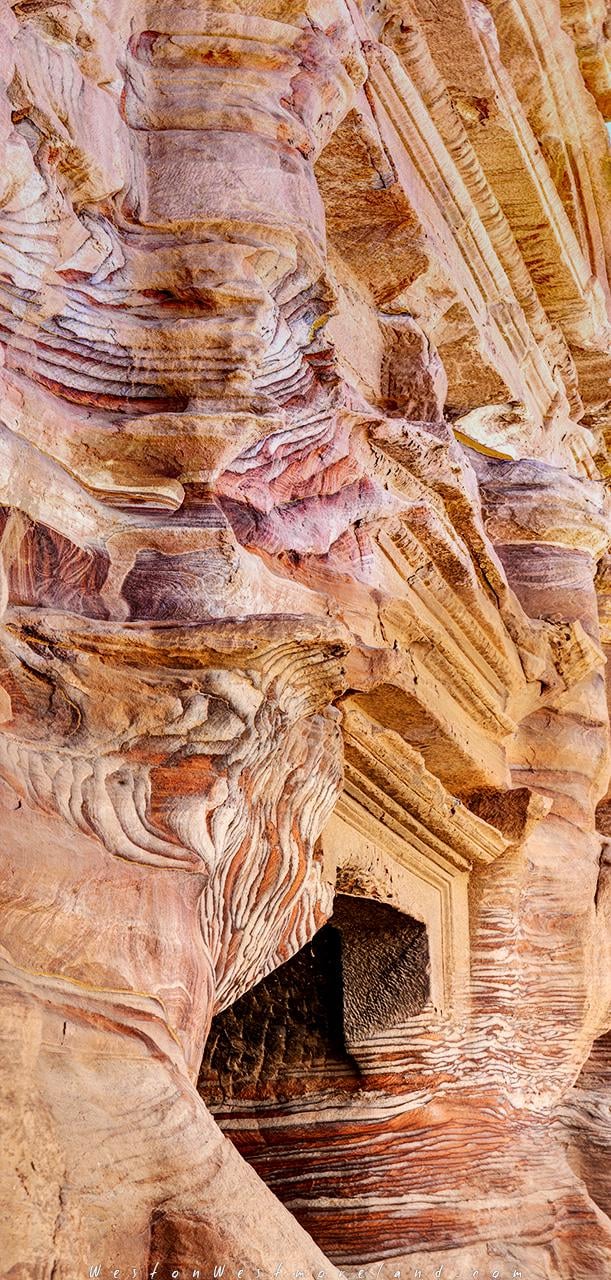
Detail of the sand-blasted entrance to the Nabatean style family tomb of Sextius Florentinus, Roman governor of Arabia Petrea for about three years. Petra, Jordan, c. 130 CE. The Romans absorbed the Nabatean Kingdom in 106 AD. The native dynasty ended but the city thrived… [1280×611] [OC]
by WestonWestmoreland

1 Comment
…It was around this time that the Petra Roman Road was built. The Romans paved the entrance, expanded the theater but also adopted Nabatean traditions, like this dug out Roman-Nabatean tomb proves.
Between 111 and 114, Trajan built the Via Traiana Nova, running from the Syrian border to the Red Sea through Petra. This road followed the old routes of Nabataean caravans. In the shadow of the Pax Romana, this route revived trade between Arabia, Syria, and Mediterranean harbors. In 130, Hadrian visited the former Nabataean capital, giving it the name of Hadriānī Petra Metropolis, imprinted on his coins. His visit, however, did not lead to any boom in development and new buildings as it did in Jerash. The province’s governor, Sextius Florentinus, erected a monumental mausoleum for his son near the end of the al-Hubta (King’s Wall) tombs, which had been generally reserved during the Nabataean period for the royal family.
Roman emperors’ interest in the city in the 3rd century suggests that Petra and its environs remained highly esteemed for a long time. An inscription to Liber Pater, a god revered by Emperor Septimius Severus, was found in the temenos of the temple known as Qasr al-Bint, and Nabataean tombs contained silver coins with the emperor’s portrait as well as pottery from his reign. Emperor Elagabalus declared Petra to be a Roman colony, when he reorganized the Roman Empire towards the end of the 3rd century. The area from Petra to Wadi Mujib, the Negev, and the Sinai Peninsula were annexed into the province of Palaestina Salutaris. The Madaba Map from the reign of Emperor Justinian I is missing the section that would include Petra.
When the city was at the height of its splendor, the issue of coinage came to an end. There was no more building of sumptuous tombs, owing apparently to some sudden catastrophe, such as an invasion by the Sasanian Empire.
Petra declined rapidly under Roman rule, in large part from the revision of sea-based trade routes. In 363, an earthquake destroyed many buildings and crippled the vital water management system. The old city of Petra was the capital of the Byzantine province of Palaestina III and many churches from the Byzantine period were excavated in and around Petra. In one of them, the Byzantine Church, 140 papyri were discovered, which contained mainly contracts dated from 530s to 590s, establishing that the city was still flourishing in the 6th century.
The last reference to Byzantine Petra comes from the first decades of the 7th century. Petra ceased to be a metropolitan bishopric sometime before 687 when that function was transferred to Areopolis. Petra is not mentioned in the narratives of the Muslim conquest of the Levant, nor does it appear in any early Islamic records…
As usual, my apologies for inaccuracies and mistakes.